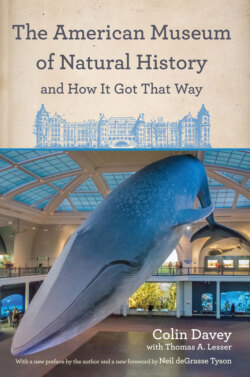Читать книгу The American Museum of Natural History and How It Got That Way - Colin Davey - Страница 8
На сайте Литреса книга снята с продажи.
ОглавлениеForeword
Neil deGrasse Tyson
T he American Museum of Natural History, on Manhattan’s Upper West Side, sits within a school-trip distance of 30 million people. My family as natives of New York City, visited. I visited with classmates. I came by myself. I came with friends. Decades later, I would bring my own kids.
Each display hall represents the slow accretion of architectural spaces, built over time, as vision and budget allowed. Within these spaces, the AMNH pioneered the diorama and the storytelling that it enabled. Previously, museums were cabinets of curiosities—collections of tagged old things on display shelves. But artifacts have history, culture, purpose, and, most importantly, emotional or spiritual value. Why not infuse static collections with a re-created life of their own? One where the visitor could, but does not need to, read the accompanying text because the diorama shows it all—the who, the when, the why, the how, and, most importantly, the context.
And when things are not artifacts but a part of nature itself—drawn from the land, the sea, the air, or the animal and plant kingdoms—they still make excellent dioramas.
My wife, raised in Alaska, was wholly unmoved by the arctic flora and fauna of the Hall of North American Mammals, with its brown bear and caribou. In particular, the moose diorama looked exactly like her walking path to the school bus. Nor did she pause for the colorful aurora borealis, meticulously painted across the diorama back panels. “That just looks like home,” she would say.
That’s surely some of the best evidence that the museum got it right. But wait, I have more.
My first time in the plains of Africa, at Kruger National Park wild game reserve, I visited a watering hole (from binocular distance) that was crowded and busy with baboons, zebras, giraffes, and wildebeests, with a small herd of large elephants ambling in the distance. My first thought, at once joyous and embarrassing, was “This scene reminds me of the African watering-hole diorama in the Akeley Hall of African Mammals at the American Museum of Natural History!”
Of course not everything in AMNH lives in a diorama. What scene would you build for the fifty-eight-ton Cape York meteorite in the Hall of Meteorites? Its native habitat is the vacuum of space. Or the dinosaur halls: bones, bones, bones. Even so, from its menacing posture, there’s no doubt that T-Rex wants to eat you.
This uncanny realism, rampant throughout the museum, is not bound to Earth. Urban kids foster no relationship with the night sky. City lights. Tall buildings. Air pollution. It all impedes your communion with the cosmos. So imagine a nine-year-old child, who had never seen or noticed the night sky before, imprinted by the star-filled dome of the American Museum’s Hayden Planetarium. Over the decades, I have come to wonder whether it was not I who chose the universe, but instead the universe that chose me.
Into adulthood, with access to the world’s greatest mountaintop observatories, I reflect on the majestic canopies of stars and I (still) say to myself, “These skies remind me of the Hayden Planetarium.”
The legacy of the Hayden Planetarium, now part of the Rose Center for Earth and Space at AMNH, extends beyond its architectural footprint. More than 100 books and 1,000 research papers have been published by members of the educational and scientific staff since it was founded in 1935. Becoming its Director (in 1996) was a call to duty, to ensure that the Hayden Planetarium I oversee has no less impact on the hearts and minds of visitors today than the Hayden Planetarium that had touched me so deeply a lifetime ago.
Such was the influence of AMNH on my ambitions and my outlook on the world. And such was the influence of AMNH on generations past and present, as will continue to be its influence on countless generations to come.
Neil deGrasse Tyson is Astrophysicist at American Museum of Natural History and Director, Hayden Planetarium.
